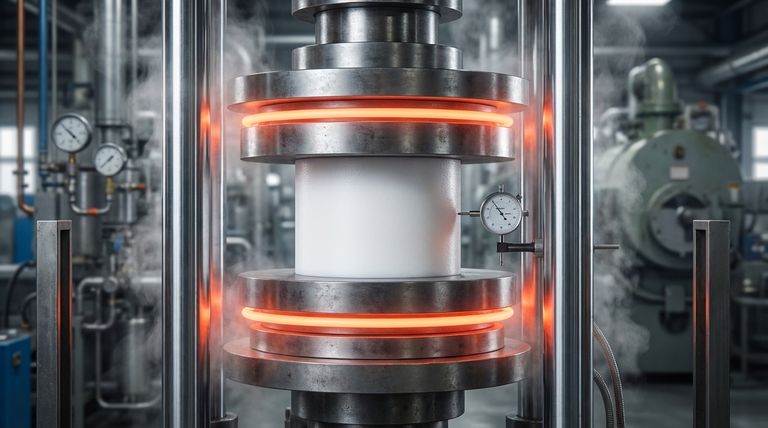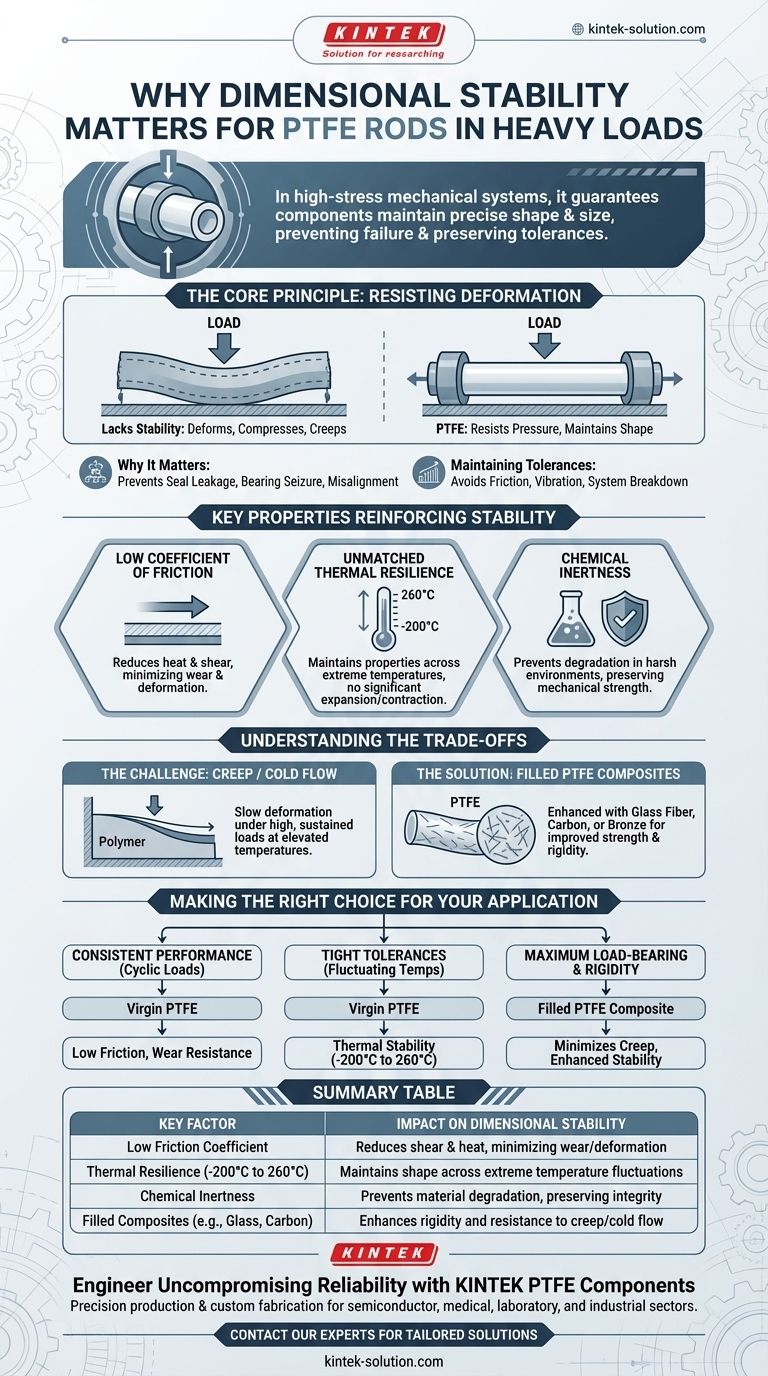In high-stress mechanical systems, the dimensional stability of a Polytetrafluoroethylene (PTFE) rod is paramount because it guarantees the component will maintain its precise shape and size under heavy, continuous loads. This prevents mechanical failure, preserves critical operating tolerances, and ensures predictable, reliable performance throughout the equipment's service life.
The true value of PTFE's dimensional stability isn't just its resistance to physical force. It is the combination of its ability to withstand mechanical stress, extreme temperatures, and chemical attack that makes it a uniquely reliable material for critical, heavy-load applications.

The Core Principle: Resisting Deformation Under Load
In any mechanical assembly, every component has a specific size and shape it must maintain to function correctly. When a material lacks dimensional stability, it can deform, compress, or "creep" under stress, leading to system failure.
Why It Matters in Heavy-Load Scenarios
Under heavy loads, materials are subjected to immense and constant pressure. PTFE's molecular structure allows it to resist this pressure without permanently changing its shape. This prevents a cascade of potential failures, such as seal leakage, bearing seizure, or loss of alignment in moving parts.
Maintaining Critical Tolerances
Modern machinery, from aerospace actuators to industrial pistons, operates with extremely tight tolerances. Even a microscopic change in a component's dimensions can cause increased friction, vibration, or a complete system breakdown. PTFE's stability ensures it holds these precise dimensions, even when compressed or stressed.
Key Properties That Reinforce Stability
PTFE's dimensional stability is not an isolated feature; it is supported by a unique combination of other elite properties. Understanding how they work together reveals why this material is so effective.
Exceptionally Low Coefficient of Friction
PTFE has one of the lowest friction coefficients of any known solid. In a load-bearing application like a bushing or slide plate, this means less heat is generated and less shear force is exerted on the material as surfaces move against each other. This drastically reduces wear and the stresses that cause deformation.
Unmatched Thermal Resilience
A material's dimensions can change significantly with temperature. PTFE is remarkable for maintaining its physical properties across a vast temperature range, from cryogenic lows (-200°C) to high-heat environments (260°C). This thermal stability ensures a PTFE component in an engine or a chemical reactor will not expand or contract enough to compromise its function.
Chemical Inertness for Long-Term Integrity
Exposure to corrosive chemicals can weaken a material's structure, making it susceptible to failure under load. PTFE is virtually inert to all chemicals. This means it will not degrade in harsh industrial environments, preserving its mechanical strength and, by extension, its dimensional stability over time.
Understanding the Trade-offs
While exceptional, PTFE is not a perfect material for every scenario. True technical expertise requires acknowledging its limitations.
The Challenge of "Creep" or Cold Flow
Like all polymers, PTFE can exhibit a phenomenon known as creep or cold flow, where it will slowly deform under a very high, sustained load, particularly at elevated temperatures. This is a critical design consideration for engineers pushing the material to its absolute limits.
The Role of Fillers for Enhancement
To counteract creep and further enhance dimensional stability, PTFE is often blended with fillers. Adding materials like glass fiber, carbon, or bronze creates a composite with significantly improved mechanical strength, rigidity, and resistance to deformation, making it suitable for the most extreme load-bearing applications.
Making the Right Choice for Your Application
Selecting the correct material requires aligning its properties with your primary operational goal.
- If your primary focus is consistent performance under cyclic loads: Rely on virgin PTFE's low friction and wear resistance, which prevent the kind of degradation that could alter component dimensions over time.
- If your primary focus is maintaining tight tolerances in fluctuating temperatures: Leverage PTFE's inherent thermal stability to ensure your component functions reliably from cryogenic pumps to high-temperature engine parts.
- If your primary focus is maximum load-bearing capacity and rigidity: Specify a filled PTFE composite (e.g., glass or carbon-filled) to minimize creep and achieve the highest possible level of dimensional stability.
By understanding these principles, you can engineer systems that are not just functional, but fundamentally reliable.
Summary Table:
| Key Factor | Impact on Dimensional Stability |
|---|---|
| Low Friction Coefficient | Reduces shear forces & heat generation, minimizing wear and deformation. |
| Thermal Resilience (-200°C to 260°C) | Maintains shape and size across extreme temperature fluctuations. |
| Chemical Inertness | Prevents material degradation, preserving structural integrity under load. |
| Filled Composites (e.g., Glass, Carbon) | Enhances rigidity and resistance to creep/cold flow for maximum loads. |
Engineer Uncompromising Reliability with KINTEK PTFE Components
When your heavy-load applications demand precision and durability, the right PTFE material makes all the difference. KINTEK specializes in manufacturing high-performance PTFE rods, seals, liners, and custom labware for the semiconductor, medical, laboratory, and industrial sectors.
We prioritize precision production and offer custom fabrication from prototypes to high-volume orders, ensuring your components deliver the dimensional stability required for critical, high-stress environments.
Contact our experts today to discuss your specific requirements and receive a tailored solution that guarantees performance and longevity.
Visual Guide

Related Products
- Custom PTFE Parts Manufacturer for Teflon Containers and Components
- Custom PTFE Parts Manufacturer for Teflon Parts and PTFE Tweezers
- Custom PTFE Measuring Cylinders for Advanced Scientific and Industrial Applications
- Customizable PTFE Rods for Advanced Industrial Applications
- Custom PTFE Sleeves and Hollow Rods for Advanced Applications
People Also Ask
- What is the temperature range that PTFE can withstand? From -200°C to +260°C for Demanding Applications
- How does PTFE compare to other low-friction plastics like UHMW-PE and Nylon? A Guide to Material Selection
- What is the hardness range of PTFE on the Shore D scale? Leveraging Its Softness for Superior Performance
- Why is PTFE considered a significant discovery? A Material That Revolutionized Industry
- What is the working temperature range of PTFE? Master Extreme Heat and Cryogenic Applications



















